THE GENIUS AND JOKES BY DARIO FO AT PALAZZO REALE IN MILAN – IL GENIO E I LAZZI DI DARIO FO A PALAZZO REALE DI MILANO
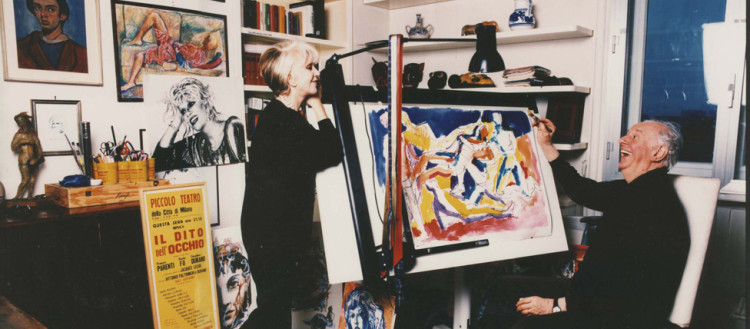
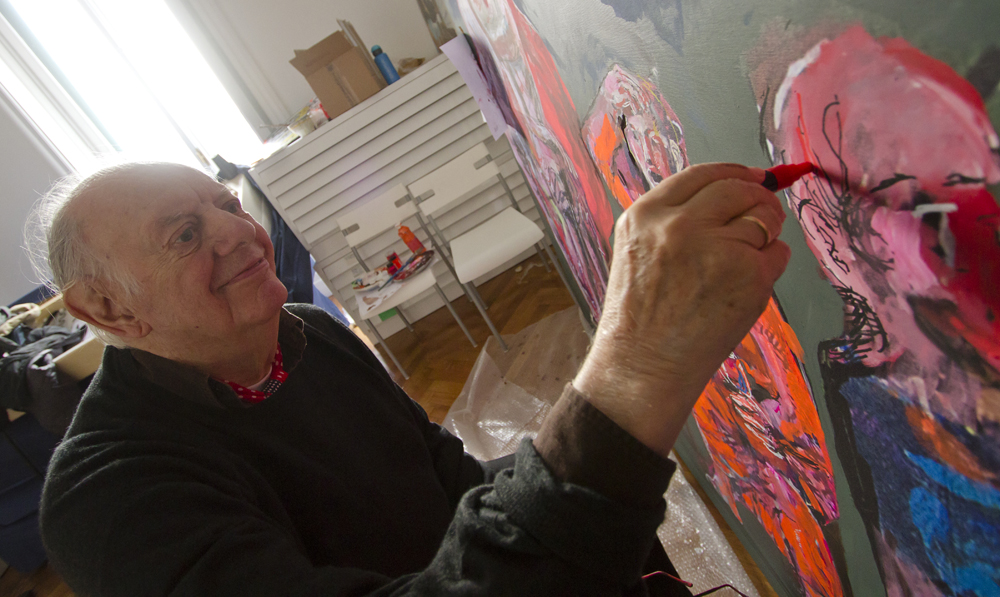
Text by Giuliana de Antonellis
The “genius” and “jokes” by Dario Fo at Palazzo Reale in Milan
from March 24 to June 3, 2012
“I always say that I am an amateur actor and professional painter.”
“If I not owned this natural ease in telling stories through pictures, I would be a mediocre writer of plays, but also tales or satirical grotesque!”
Dario Fo
These are the phrases that introduce you to a show, that besides being a tribute to a son of his homeland, is also a tribute to a man in Milan who through all the expressions of Art (written in capital letters), has given his city and the whole nation the gift of his “genius”.
An extraordinary man of the theater and the Nobel Prize for Literature in 1997, Dario Fo is also known for his social commitment. But not everyone knows him as a painter, despite this language has always accompanied his work in theater and has even preceded it. It is said that his mother bought paper and pencils and ordered them to draw, rather than go down the street to play as his friends. True or not some of his artistic talent has always accompanied and still accompanying him, as he demonstrated during the “artist’s workshop”, created specifically to show the deep bond between Fo and painting at the Palazzo Reale. It is in the shop – understood in its meaning Renaissance – Dario Fo, from drawings and paintings, then elaborates on her canvases brought on the scene.
Dario Fo, the exhibition in Milan. jeers, sneers, paintings at the Royal Palace from March 24 to June 3, is an important opportunity to understand how the painting has been a mainstay in the expressive language of Fo. A witness to the endless and unpredictable creativity of the artist are on display over 400 works with a wide variety of styles and techniques: paintings from the early collages and tapestries, to the most recent monumental acrylics. Also on display props, masks, puppets and puppets, including historical ones belonging to the family copper. Nourished by the presence of drawings, sketches, watercolors, sketches of costumes, backdrops, large sets, posters and prints by osmosis have become an integral part of the dramaturgy of Fo Theatre Company – Copper. All this immense wealth can admire and enjoy thanks to the work of Franca Rame, his wife, who has filed and preserved as relics for posterity.
She herself said to be good and archivist and the display is only part of the monumental work of “genius” of Darius, who played 86 years to life and you wonder what he does as a boy once. The visitor will have the opportunity to have him as a guide to fully enjoy his work, his color, his jokes, his grimaces, his …. ART.
The exhibition tour starts by going straight to the heart of the political and social satire that Dario Fo has always practised, in his painting and in his theatre: this subject culminates in the large “speaking” canvases made especially for the Palazzo Reale exhibition.
The curator Felice Cappa commented on this section of the exhibition: “True to the narrative dimension of his painting, Fo proposes some fundamental political moments in the recent history of Italy and the great international events in the era of globalization and the dictatorship of finance. Also documented are the long period under Berlusconi, the errancy and the decline of Italian politics, episodes of corruption and real estate speculation, the mismanagement of emergency relief in areas struck by earthquakes and the like. This section will be enriched by the works completed in the Artist’s Workshop.”
The exhibition then accompanies the visitor on a long tour of the “history of art”: from the works inspired by the prehistoric rock carvings to our own time, passing through the languages of classical Greek and Roman times to the preciousness of the mosaics of Ravenna and Byzantium. Dario Fo’s interest in medieval and Renaissance art is reflected in the works celebrating the sculptural reliefs of the Modena Cathedral and the decoration of the Parma cathedral, together with the studies and how-lessons about Giotto and Pietro Cavallini, Mantegna, Giulio Romano, Michelangelo, Leonardo, Raffaello, Correggio, and Caravaggio.
The art history tour is interrupted with Tiepolo, and the exhibition continues with the Fo’s direction of Rossini’s works: The Barber of Seville (1987), Italian Girl in Algiers (1994), La Gazzetta (2001), and Journey to Rheims (2002). Here Dario Fo builds the most consistent visual documentation, elaborating an impressive series of boards and drawings, many of which are included in the exhibition alongside those dedicated to the theatre of Moliére and Stravinsky’s Histoire du soldat, a masterpiece that he revisited and staged at Teatro alla Scala in 1978.
The Collettivo Teatrale La Comune, founded by Dario Fo and Franca Rame in 1974, enjoyed a fertile period at the Palazzina Liberty, commemorated in the exhibition with the works created by Sebastian Matta for that space.
The tour continues with an account of the meeting with Franca Rame in 1952. Heir to a family of itinerant artists who since the seventeenth century worked in the tradition of the commedia dell’arte, Franca Rame helped Dario Fo discover satire as a key tool in his artistic expression.
The exhibition concludes with a section dedicated to Fo’s artistic training, from his earliest studies on his native Lake Maggiore to his move to Milan and his enrolment at the Brera Academy, where he met such teachers as Achille Funi, Carlo Carrà, and Aldo Carpi.
Extraordinary archival documents made it possible to create completely new video montages, though which we can reconstruct the right balance between the theatrical and pictorial works and the historical, artistic, and social contexts that inspired them. Twenty screens document the exhibition room by room, through the show-lessons offered by Daio Fo and Franca Rame. Moreover, in another room, there will be projections of the theatrical performances and films, starting with Lo Svitato, from 1956. Given the great quantity of materials available, the programs will be renewed every 2 days.
The catalogue, produced by Edizioni Gabriele Mazzotta, bears witness to the longstanding alliance between the publishing house and Dario Fo. In addition to having published the catalogue to the recent exhibition at the m.a.x. museo in Chiasso, Dario Fo. La pittura di un narratore (Dario Fo. A Narrator’s Painting), and having hosted in 1999 in his own Foundation’s spaces in Foro Buonaparte the exhibition entitled Federico Fellini & Dario Fo. Disegni geniali (Federico Fellini & Dario Fo. Brilliant Drawings), from as early as 1970 Gabriele Mazzotta has published materials about Dario Fo and Franca Rame’s theatre, including their most famous work of all, Mistero Buffo (Comic Mystery).
There will also be guided tours for schools of all levels, and for groups and families, curated by the Ad Artem. The Spotlight srl company, leader in Italy and around the world in lighting for entertainment and the architectural sector, has offered its support, supplying the professional lighting for the displays. The exhibition has also benefited by the collaboration of the media partners Fondazione Corriere della Sera, Radio Lifegate, and Televisionet.
Giuliana de Antonellis – www.gdapress.it
Infoline 02 54913 – www.mostradariofo.it – www.comune.milano.it
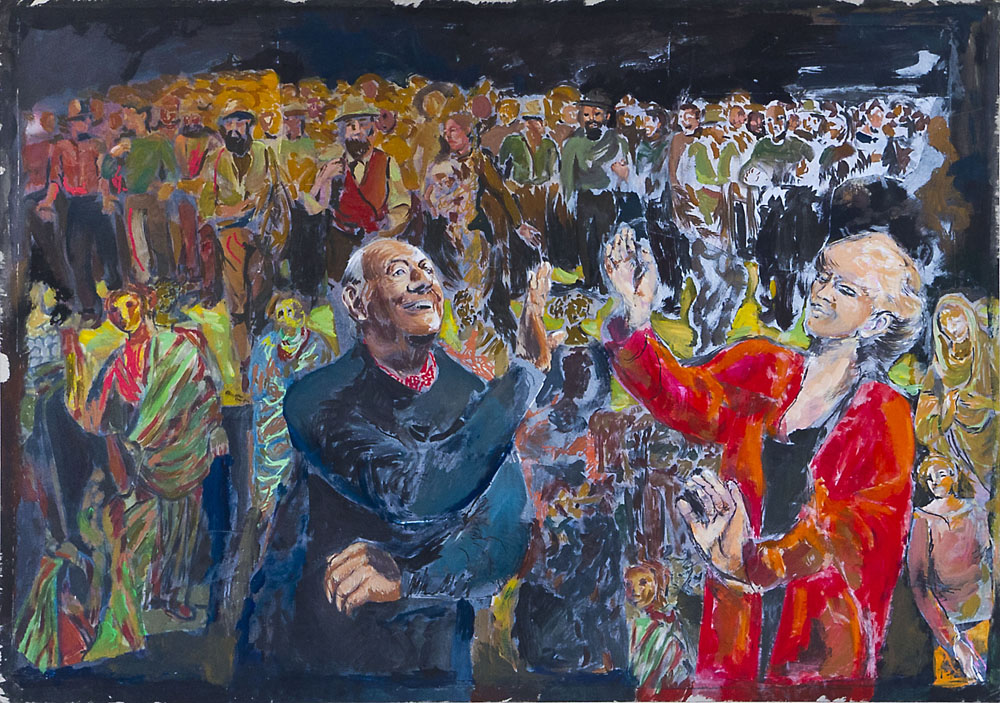
Articolo di Giuliana de Antonellis
Il “genio” e i “lazzi” di Dario Fo a Palazzo Reale di Milano
dal 24 marzo al 3 giugno 2012
“Dico sempre che mi sento attore dilettante e pittore professionista.”
“Se non possedessi questa facilità naturale del raccontare attraverso le immagini, sarei un mediocre scrittore di testi teatrali, ma anche di favole o di grotteschi satirici!”
Dario Fo
Queste le frasi che introducono ad una mostra, che oltre ad essere un tributo ad un figlio della sua terra, è anche l’omaggio di Milano ad un uomo che attraverso tutte le espressioni dell’Arte, con la A maiuscola, ha dato alla sua città e alla nazione intera in dono il suo “genio”.
Straordinario uomo di teatro e Premio Nobel per la letteratura nel 1997, Dario Fo è noto anche per il suo impegno sociale. Non tutti però lo conoscono come pittore, nonostante questo linguaggio abbia accompagnato da sempre la sua attività teatrale e l’abbia anzi preceduta. Si racconta che la madre gli comprasse fogli e matite e gli intimava di disegnare, piuttosto che andar per la strada a giocare come i suoi amici. Vero o no di certo la sua vena artistica lo ha da sempre accompagnato e lo accompagna ancor oggi, come ha dimostrato durante “la Bottega d’artista”, creata appositamente per mostrare il profondo legame tra Fo e la pittura, a Palazzo Reale. È nella bottega – intesa nella sua accezione rinascimentale – che Dario Fo, partendo da disegni e dipinti, elabora i suoi canovacci portati poi sulla scena.
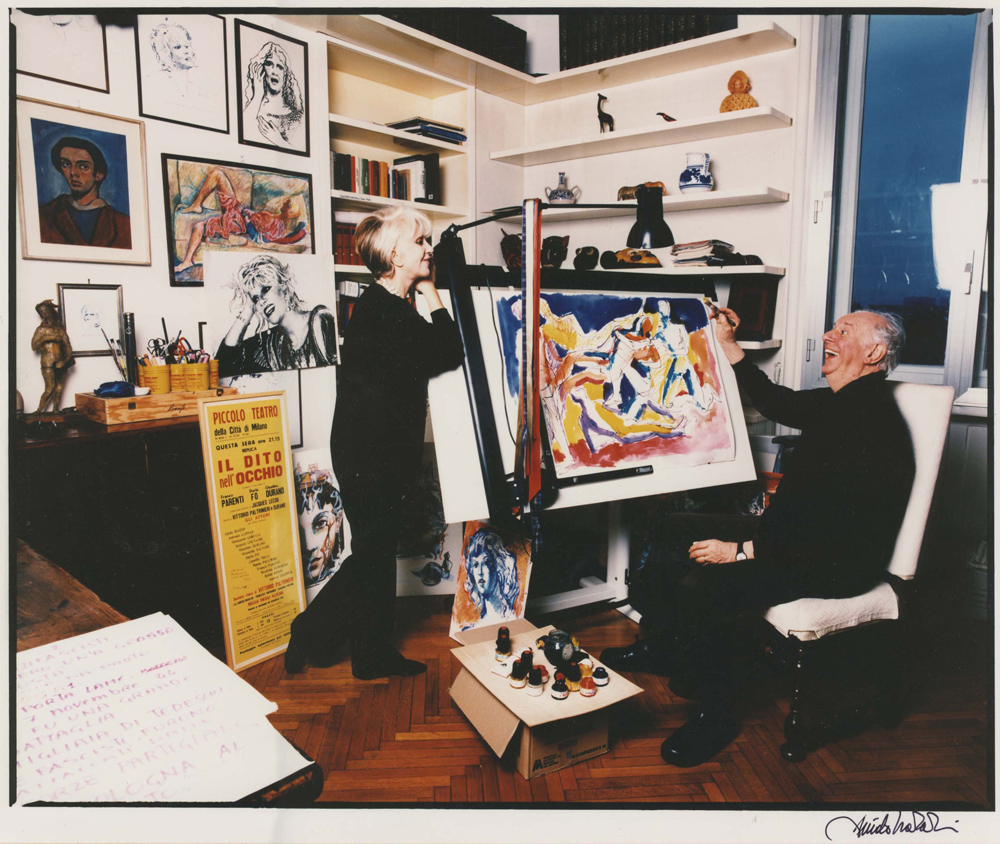
La mostra Dario Fo a Milano: lazzi, sberleffi, dipinti, a Palazzo Reale dal 24 marzo al 3 giugno, è un’importante occasione per comprendere come la pittura abbia costituito un punto cardine nel linguaggio espressivo di Fo. A testimoniare l’inesauribile e imprevedibile creatività dell’artista sono esposte oltre 400 opere con una grande varietà di stili e tecniche: dalle pitture dei primi anni ai collages e agli arazzi, fino ai monumentali acrilici più recenti. In mostra anche oggetti di scena, maschere, marionette e burattini, tra cui quelli storici appartenuti alla famiglia Rame. Nutrita la presenza di disegni, schizzi, acquarelli, bozzetti di costumi, fondali, ampie scenografie, locandine e stampe che per osmosi sono diventati parte integrante della drammaturgia della Compagnia Teatrale Fo – Rame. Tutto questo immenso patrimonio è possibile ammirarlo e goderne grazie all’opera di Franca Rame, sua moglie, che ha archiviato e conservato come reliquie per i posteri.
Lei stessa ha dichiarato di essere una brava archivista e che quello esposto è solo una parte della monumentale opera del “genio” di Dario, che ad 86 anni suonati si stupisce della vita e di ciò che fa come il ragazzo di una volta. Il visitatore che avrà l’occasione di averlo come cicerone godrà appieno della sua opera, dei suoi colori, dei suoi lazzi, dei suoi sberleffi, …. della sua ARTE.
Il percorso espositivo si apre entrando nel vivo della satira politica e di costume da sempre praticata nell’arte di Dario Fo, in pittura e in teatro: questo discorso culmina nelle grandi tele “parlanti” realizzate appositamente per la mostra di Palazzo Reale.
La mostra accompagna poi il visitatore, in un lungo viaggio attraverso la “storia dell’arte”: dai lavori ispirati alle incisioni rupestri preistoriche ai nostri giorni, attraversando i linguaggi della classicità greca e romana sino alla preziosità dei mosaici ravennati e bizantini. L’interesse di Dario Fo per l’arte del Medioevo e del Rinascimento è testimoniato dai lavori che celebrano i rilievi scultorei del Duomo di Modena e la decorazione del Duomo di Parma, insieme agli studi e dalle lezioni-spettacolo su Giotto e Pietro Cavallini, su Mantegna, Giulio Romano, Michelangelo, Leonardo, Raffaello, Correggio e Caravaggio.
Con Tiepolo si interrompe il cammino nella “storia dell’arte” per proseguire con le regie delle opere rossiniane: Il Barbiere di Siviglia (1987), L’Italiana in Algeri (1994), La Gazzetta (2001) e Il Viaggio a Reims (2002). Qui Dario Fo costruisce la più consistente documentazione visiva, elaborando un’impressionante serie di tavole e disegni, molti dei quali presenti in mostra accanto a quelli dedicati al teatro di Molière e all’Histoire du soldat di Stravinsky, capolavoro da lui rivisitato e allestito al Teatro alla Scala nel 1978.
La creativa stagione alla Palazzina Liberty del Collettivo Teatrale La Comune, fondato da Dario Fo e Franca Rame nel 1974, è ricordata in mostra attraverso la presenza di opere che Sebastian Matta realizzò per quello spazio.
Il percorso prosegue documentando l’incontro con Franca Rame avvenuto nel 1952. Appartenente a una famiglia di artisti girovaghi, che dal Seicento operò nel solco della tradizione della commedia dell’arte, Franca Rame fece scoprire a Dario Fo la satira come strumento fondamentale per la propria elaborazione artistica.
La mostra si conclude con una sezione dedicata alla formazione artistica di Fo, dai primi studi sul natio Lago Maggiore al trasferimento a Milano e alla frequentazione dell’Accademia di Brera, dove incontrò maestri come Achille Funi, Carlo Carrà e Aldo Carpi.
Una straordinaria documentazione d’archivio ha consentito la realizzazione di inediti montaggi video, attraverso i quali è possibile ricostruire il giusto rapporto tra le opere teatrali e pittoriche e il contesto storico, artistico e sociale che le ha ispirate. Venti schermi documentano sala per sala la mostra, attraverso le lezioni spettacolo tenute da Dario Fo e Franca Rame. Inoltre, in una sala di proiezione, saranno visibili al pubblico le rappresentazioni teatrali e i film a partire da Lo Svitato del 1956. Data la gran quantità di materiali a disposizione, i programmi saranno rinnovati ogni 2 giorni.
Il catalogo, realizzato dalle Edizioni Gabriele Mazzotta, è la testimonianza del lungo sodalizio tra la casa editrice e Dario Fo. Oltre ad aver pubblicato il recente catalogo della mostra Dario Fo. La pittura di un narratore al m.a.x. museo di Chiasso e aver ospitato nel 1999 la mostra Federico Fellini & Dario Fo. Disegni geniali negli spazi della propria Fondazione in Foro Buonaparte, Gabriele Mazzotta ha curato fin dal 1970 pubblicazioni sul teatro di Dario Fo e Franca Rame, compresa la loro opera più famosa in assoluto: Mistero buffo.
Giuliana de Antonellis – www.gdapress.it/
Info: www.mostradariofo.it – www.comune.milano.it – Infoline 02 54913
Position the cursor on the images to view captions, click on images to enlarge them.
Posizionare il cursore sulle immagini per leggere le didascalie; cliccare sulle immagini per ingrandirle.
SCHEDA TECNICA
| SEDE | Palazzo Reale |
| DATE MOSTRA | 24 marzo – 3 giugno 2012 |
| DATE BOTTEGA D’ARTISTA | 13 – 18 marzo 2012 dalle 10.00 alle 12.30 su prenotazione al numero 02.54913dalle 12.30 alle 17.30 ingresso libero fino ad esaurimento posti |
| DATE EVENTI E INCONTRI | Il programma sarà disponibile sul sito www.mostradariofo.it |

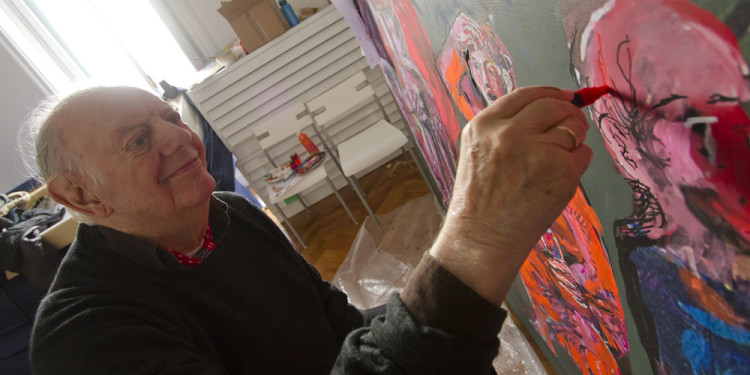
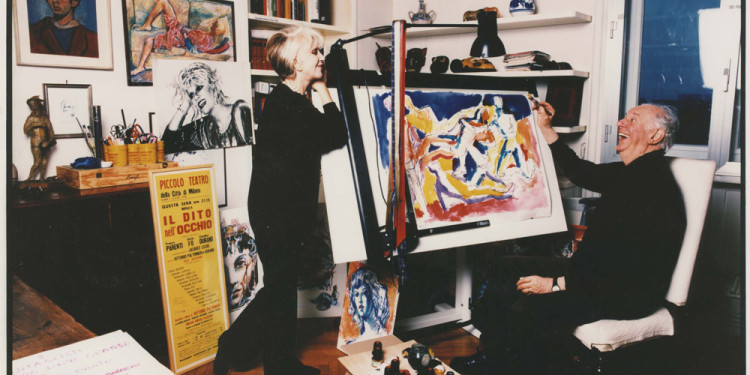
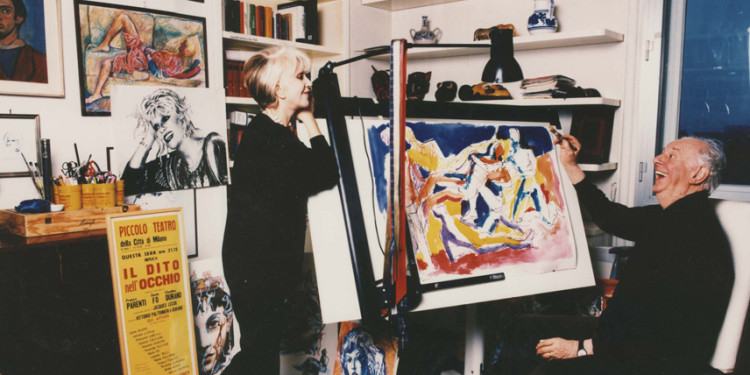
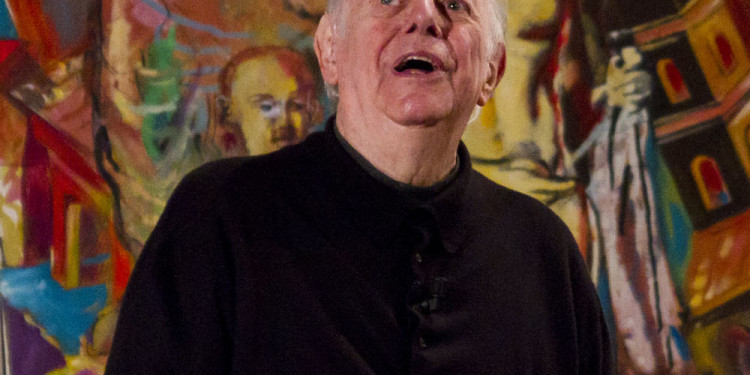
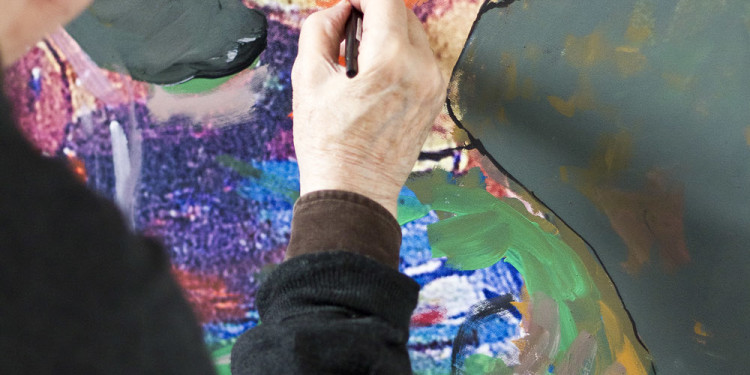
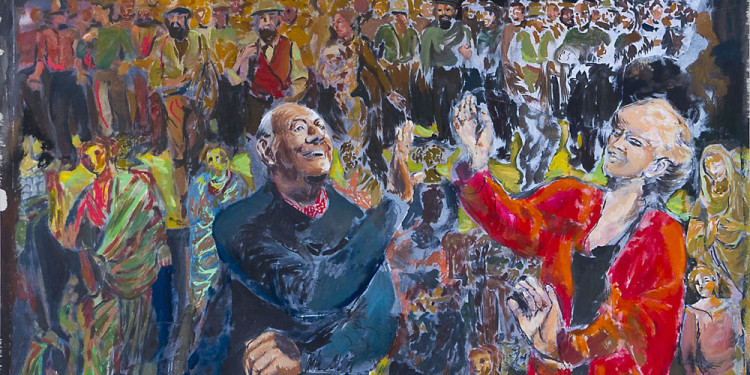
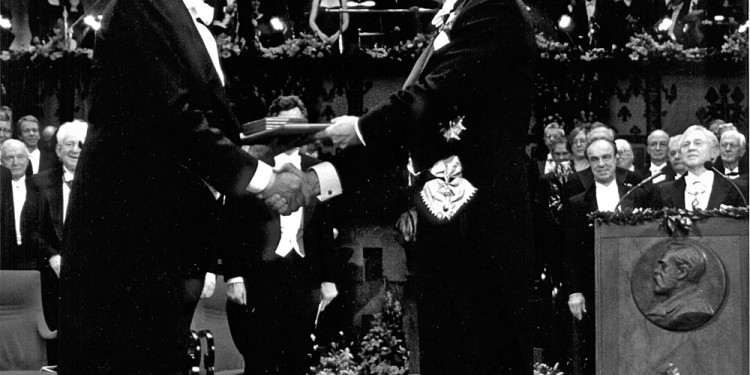
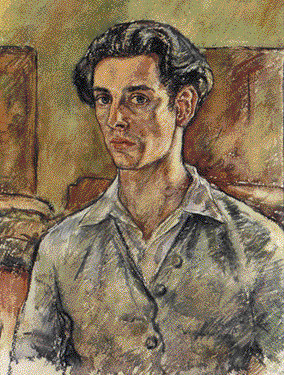
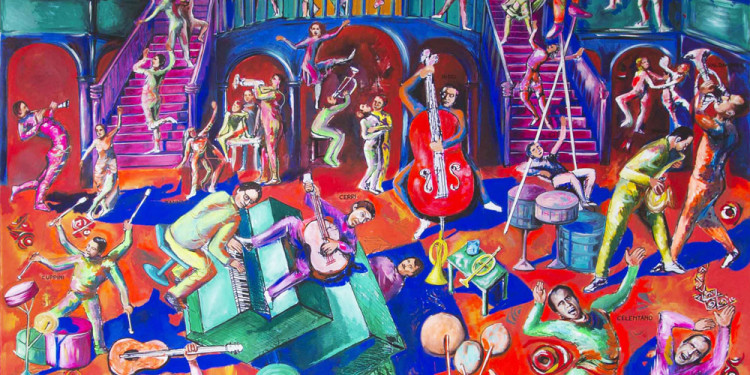
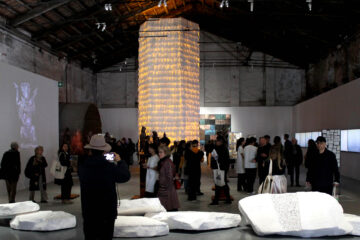
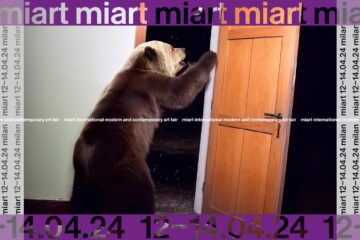
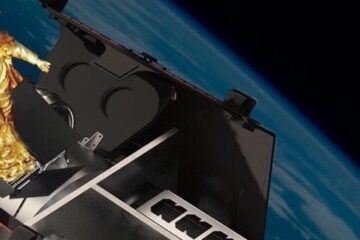
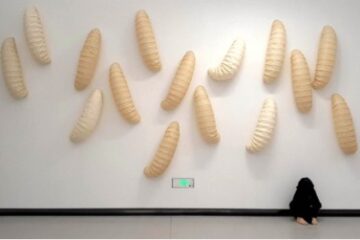
No Comment